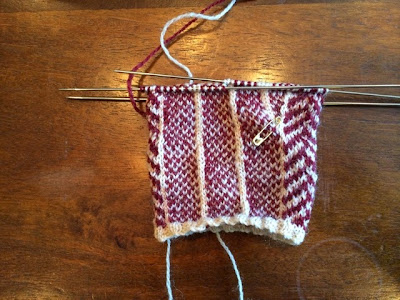As reported in the last post, it was my
fourth start that was successful and it went well until I began knitting
fingers. Those small tiny circumferences
are tricky. I ended up knitting too
tight or too loose, requiring unknitting and knitting here and there. I may have knitted 10 fingers or more
to get them right. I need to check my
knitting regularly it seems.
I also noticed, depending on the
thickness of the yarns which is not consistent, my stitch size varied. What
can I say. I would love to find a wool/silk blend lace weight yarns
for the next pair of gloves. Any
suggestions?
With Lisa’s advice, I decided to place the little finger a bit lower
than the other three fingers. I slipped stitches
for the little finger onto safety pin 7 rounds before starting the other
fingers (on the fifth round of the fifth pattern repeat): Knit 11 stitches and
transfer them to a safety pin, continue knitting 68 stitches, and transfer the
remaining 9 stitches to a safety pin. To
complete the round, cast on 9 stitches for a gusset and join.
The rest of the glove was knitted per
instruction, except the number of rows in checkerboard pattern at the tip of
the middle finger: I knit 1 row only instead of 3.
Notes:
- At the start of each finger, two dark
colored stitches are picked up at the beginning of the round. Pick them up and knit by inserting a needle
into stitches. When inserted between
stitches, a hole was visible.
- Hold the right needles below the needle
with stitches just finished. It is
easier to control tension when held in this manner.
- On last two rows at finger tips:
- Distribute stitches so that all three needles have the same stitch count and the stitch pattern: BWBWBWBWBWB.
- Next round: ssk in B, ssk in W, k2tog in B, W, ssk in B, k2tog in B: Choose ssk and k2tog so that the stitch on top has different color from the stitch to be knitted.
- Last round: ssk in B, ssk in W, k2tog in B.




.jpg)















